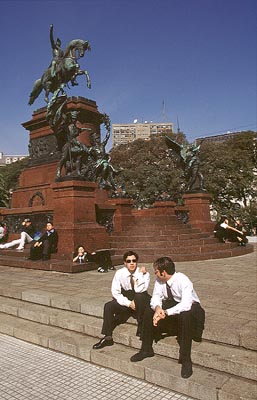|
 |
|
Statues |
||
Buenos Aires
From the air, the city looks massively packed with concrete buildings. The sense of its scale and compactness is reinforced when the bus from the airport ran straight through the crowded and busy city for more than an hour. It comes as no surprising when you realise that almost half of the country population congregates and lives in this capital's sprawling suburbs.
The buildings spurring up in the city are old and faded, giving them a sick, weary look and feel. They may be elegantly constructed in their olden days but their charm, just like the peeling paint on their corroded walls, are now eroded away with time. They are neither new enough to have the modern and refreshing look nor old enough to have the classic and antique appeal. It appears that the city is long due for an overhaul and upgrading. The bald, dead looking trees along the side of the avenues only make the city look more dull and lifeless.
|
 |
|
Statues |
||
Scattering all over the city are landmark Plazas. I have initially envisioned these plazas to be some huge prominent shopping malls as to how the word plaza is termed in Singapore. It turns out to be just a park in an open area amidst the crowded buildings, inevitably comes together with a huge monuments or statues. Major plazas, like Plaza de Mayo and Plaza de Congreso, are situated near historical buildings and the pulse of the city's activities.

Subway train
Radiating out from downtown Plaza de Mayo are the subway lines. There are altogether 5 lines serving the commuters of the city. Some lines are run by old but classically tasteful trains whereas others are run by modern but bland looking. The whole system is the oldest in Latin America but it is a fast and cheap way to get around the city. Changing lines could be confusing as to which station to change to which line and which direction to board. They have all the helpful and informative signboards but are all in Spanish. Having a map of the network to ask for direction could be more useful. Charging a flat rate of 60 cents for each ride, commuters buy a token to get through the gate.
Called the colectivo, the buses also run an extensive network in the city. Flag down the bus from its designated stops, tell the driver your destination and then slot the coins into the machine. Only one ticket will be dispensed when two or more of you are travelling together. Touts and activists often get up the bus for free and try to sell you their stuffs or distribute pamphlets. The buses are non-aircon and seats are fairly comfortable.
Taxis are the most expensive form of transport. It cost me about US$40 to get from the city to the international airport. I had no choice but to rush down to the airport by taxi when a crashed plane closed the domestic airport. However, the taxi ride took me only half an hour instead of the 2 hours by bus.
Walking is a good way to see and feel the city. Traffic condition is orderly and friendly to pedestrains though Avenida 9 de Julio, being the widest street in the world, can be a nightmare to cross. Unless one has ample time, the city is simply too big to cover on foot.
|
|
The winter season in August is still cold and chilling. Mingling in the street of Florida with those sophisticatedly dressed in 3 piece suits and coats are beggars and street buskers. And among these dully but seriously dressed, is a Chinese guy oddly and conspicuously dressed in a strikingly bright orange fleece, frequently pausing and referring to his photostatted map for direction. Florida is a crowded shopping promenade closed to motor vehicles. Most of my time was spent around here arranging for my flight tickets in the tour agency and applying for visa in the embassies.
Mention Buenos Aires and one would immediately think of Tango. The sexy and erotic dance was originated from the brothels frequented by the immigrants. The music was a fusion of the European and African music. Street performance is common or you may pay to watch in one of the many dance halls or Tango clubs. Pity that I have no opportunity to watch the dance.
Touted as the Paris of the South, Buenos Aires indeed has some similarities of a European city with statues, sidewalk cafes, prêt-à-porter windows and the exorbitant prices. But the city is too run-down and the element of romance is somehow missing. It falls way short of my expectation to be the place to begin my honeymoon.
La Boca
La Boca is located at the south eastern side of the city. It is famous for its sheet-iron houses painted with multi striking bright colours.

Colourfully painted houses

Tourists taking a rest

Back street of La Boca
[ Back ]